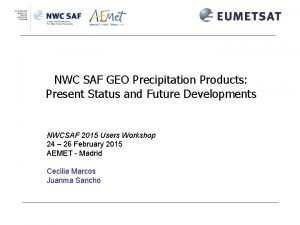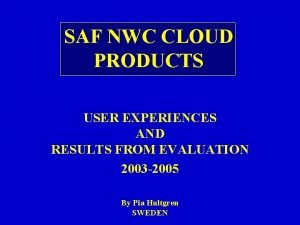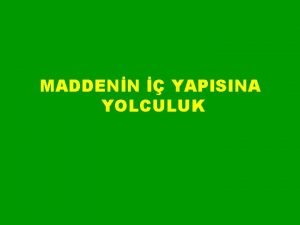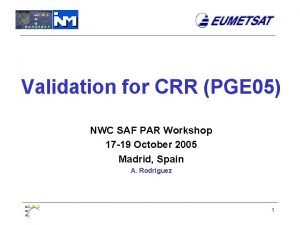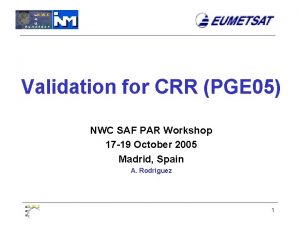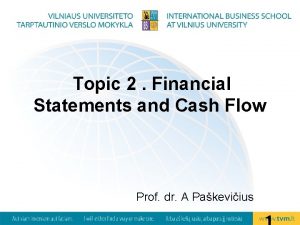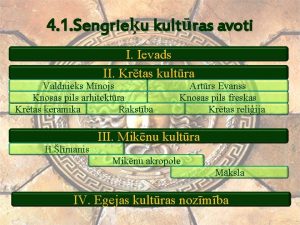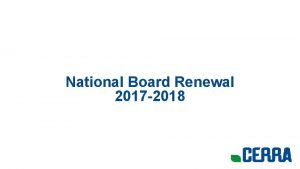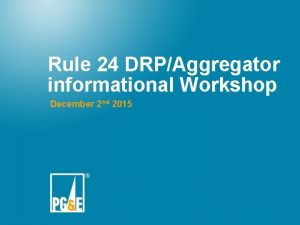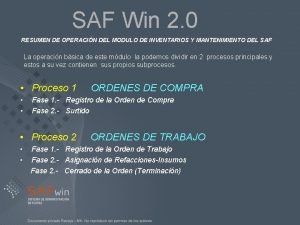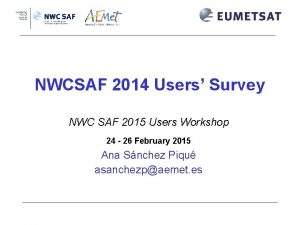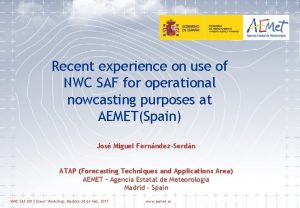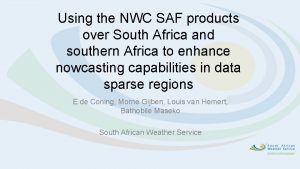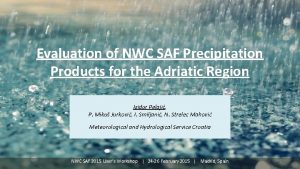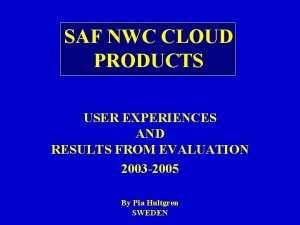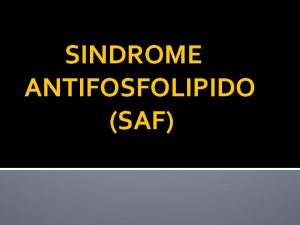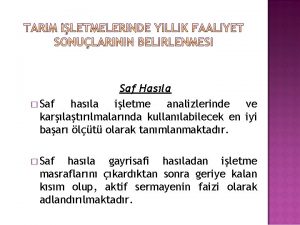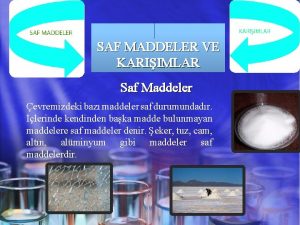Validation for TPW PGE 06 NWC SAF PAR























- Slides: 23

Validation for TPW (PGE 06) NWC SAF PAR Workshop 17 -19 October 2005 Madrid, Spain P. Fernández 1

General Validation Objectives The main goal is to compare the TPW values obtained from SEVIRI data with a true pattern TPW. To this end datasets are being created in real time containing the necessary parameters to provide statistical results. Two different sources have been used: Ø SEVIRI TPW data matching Radio-sounding sites. Ø SEVIRI TPW data compared with TPW ECMWF grid point data. 2

Methodology outline Data have been processed twofold: Ø The product correlation has been obtained by linear regression displayed as scatter plots with the BIAS, RMS and Correlation parameters. Radio Sounding data and ECMWF numerical model data have been used. Ø In order to know the spatial behaviour of the errors, the ASCII datasets created with ECMWF data have been reprocessed to convert the TPW values in images in a Mc. IDAS AREA format. This method allows operating the brightness image values performing the statistical parameters in a geographical pattern. Ø Earlier TPW SEVIRI data than the 4 th April 2005 (SAFNWC/MSG v 1. 2 running at INM from the 5 th April 2005) have been added without reprocessing the corresponding images, just calculating the TPW by using the same SAFNWC v 1. 2 algorithm and conditions for each Radio 3

TPW v 1. 2 versus Radio Sounding TPW data Observed TPW data versus calculated TPW by using the same SAFNWC v 1. 2 algorithm and conditions for each Radio Sounding site after SAFNWC/MSG v 1. 2 running start. Same for each ECMWF GRID point - 4

TPW v 1. 2 versus Radio Sounding TPW data Ø LAND TPW has been validated with 00, 06, 12 &18 UTC Radio Sounding data from the 1 st January 2005 to the 31 st July 2005 (previous dates were used for the tuning). Ø A few Radio Sounding stations over the coastline were assumed to be SEA pixels by the LAND/SEA mask used into the SAFNWC process and hence originally processed with the TPW SEA algorithm. - ØThe Radio Sounding validation for SEA TPW has been done with a full year of data from the 1 st August 2004 to the 31 st July 2005 (tuning made with ECMWF data). 5

TPW v 1. 2 versus Radio Sounding TPW data FILTERING: In order to assure clear air conditions, the next Radio Soundings were rejected during the process using the next flags included in the dataset creation: ØSoundings with FLAG >0 (number of times with profile differences (TTd) less than 1) ØSoundings with NLEV<20 (profile number of levels) ØSoundings with ULEV>100 HPa (profile upper level) ØSoundings with CLOUD>=5 (cloud octas obtained from SYNOP) 6

TPW v 1. 2 versus Radio Sounding TPW data Radio Soundings used for the dataset creation Radio Soundings used for LAND validation after filtering Radio Soundings used for SEA validation - 7

TPW v 1. 2 versus Radio Sounding TPW data LAND (01/01/2005 31/07/2005) SEA (01/08/2004 31/07/2005) ALL (01/08/2004 31/07/2005) BIAS 1. 78 -1. 85 0. 66 RMS 4. 66 4. 99 4. 80 R 0. 87 0. 81 0. 84 NDATA 2184 1244 3428 8

TPW v 1. 2 versus ECMWF TPW data Ø ECMWF analysis data at 00 and 12 UTC from the 1 st January 2005 to the 31 st July 2005 were processed to obtain the scatter plots for LAND and SEA (previous dates were used for the tuning). Ø As the X-PLUS processing tool does not allow managing more than 33000 data, a selection of one day over three has been made as well as one grid point each 1. 5 degrees latitude and longitude. - Ø ECMWF analysis data at 00 and 12 UTC from the 1 st August 2004 to the 31 st July 2005 were processed to perform the spatial behaviour of the statistical parameters. Ø The full dataset has been used (0. 5 degrees latitude and longitude) Desert points contain all the grid points with latitude lower than 35ºN. 9

TPW v 1. 2 versus ECMWF TPW data FILTERING: In order to assure clear air conditions, a number of grid points were rejected using the next flags included in the dataset creation: Ø GRID points with FLAG >0 (number of times with profile differences (T-Td) Ø GRID points with CLOUD COVER>=70%(cloud cover obtained from ECMW 10

TPW v 1. 2 versus ECMWF TPW data DESERT LAND WITHOUT DESERT BIAS 2. 90 4. 63 0. 75 RMS 6. 45 7. 63 4. 58 R 0. 67 0. 52 0. 83 15945 8844 7101 NDATA 11

TPW v 1. 2 versus ECMWF TPW data ALL SEA ALL WITHOUT DESERT BIAS 0. 47 1. 78 0. 57 RMS 4. 34 5. 58 4. 42 R 0. 83 0. 75 0. 84 13633 29578 20734 NDATA 12

Spatial Behaviour In order to test the performance of the TPW product in each grid point, a grid spatial distribution for two statistical parameters (BIAS and RMS) has been created. That allows: Ø to evaluate the deviation from the truth in a geographical pattern Ø to visualize the areas in which the product has to be improved. 13

BIAS Spatial Behaviour. In average -3. 0 < BIAS < 3. 0 -6<BIAS<-3 over sea high latitudes -6<BIAS<-3 over the west Mediterranean 3<BIAS<6 over the Atlantic low latitudes - -6<BIAS<-3 over the mountains 3<BIAS<6 over the Black sea area BIAS>6 over desert areas 14

RMS Spatial Behaviour In average RMS < 6. 0 RMS>5 over the Mountains RMS>6 over the Black sea area RMS>6 over the Atlantic low latitudes - RMS>9 over desert areas 15

TPW Loop 1 JUN 2005 TPW ECMWF 1 JUN 2005 12: 00 TPW ECMWF 1 JUN 2005 18: 00 16

Canary Islands Case 17 -18 AUGUST 2005 PW Sounding=31. 60 17

Conclusions The PGE 06 TPW v 1. 2 correlates well with the “truth patterns” used in validation, but: Ø The TPW image features has shorter range values than the “truth”. Some geographical areas present difficulties to be well monitored, mainly: Ø Desert areas Ø High latitudes SEA areas Ø Mountain Areas Nevertheless: Ø The TPW highest values obtained have been proved to be useful in situations prior to convection. 18 Ø The PGE 06 TPW v 1. 2 is then fully usable for Now casting

Future Developments Ø Emissivity data incorporation to the algorithm to improve desert areas features. Ø Better representation of Diurnal and Seasonal cycles (Surface Temperature or other air mass low levels indicator) Ø Impact of the use of the other channels added to the main algorithm. 19

PGE 06 Quality Analysis üThe quality of the product has been assessed indirectly, through the validation of DSLF using TPW (v 1. 0) from NWCSAF and ECMWF forecasts; the latter tends to perform better. üRather good for spatial features distribution. üLack of sensitivity (actual range is quite reduced). üDiurnal cycle still too much apparent. üThere is lower gradation of Precipitable values than LPW-PGE 07. ü Land/Sea not homogenize. 20

Improvements and modifications to PGE 06 requested/suggested by users ü Reduce LPW (total) and TPW to just one product. Not foreseen. ü Improve the sensibility. ü Improve the diurnal cycle. Same problem and solution: Better representation of Diurnal and Seasonal cycles (Surface Temperature or other air mass low levels indicator) ü Land/Sea homogenization Not further idea at present time. 21

TPW TEST with Radio Sounding TPW data TPW v 1. 2 (01/08/2004 31/07/2005) TPW TEST (01/08/2004 31/07/2005) - Seasonal Cycle modulated with Sounding Surface Temperature 22

Improvements and modifications to PGE 06 requested/suggested by the developer ü Impact of the use of the other channels added to the main algorithm. ü Determine if IR 8. 7 is fully useful (emissivity problems). ü New tuning with Integrated Water Vapor GPS. 23
 Nwc saf
Nwc saf Saf nwc
Saf nwc Saf madde saf olmayan madde
Saf madde saf olmayan madde Saf par
Saf par Saf par
Saf par Saf par
Saf par Fur trade 1670
Fur trade 1670 Nwc change
Nwc change Metode transportasi nwc, lc dan vam
Metode transportasi nwc, lc dan vam Chapter 10 making capital investment decisions
Chapter 10 making capital investment decisions Contoh metode modi
Contoh metode modi Change in nwc equation
Change in nwc equation Advantages of capital budgeting
Advantages of capital budgeting Hbc vs nwc
Hbc vs nwc Nwc change
Nwc change Kupolveida kapenes mikēnās
Kupolveida kapenes mikēnās Pg&e ev fleet
Pg&e ev fleet Csi epbb calculator
Csi epbb calculator Pge marketing et gestion du sport
Pge marketing et gestion du sport National board pge examples
National board pge examples Rule 24 ml
Rule 24 ml Apa format reference page
Apa format reference page Saf maddelerin özellikleri
Saf maddelerin özellikleri Saf win
Saf win
